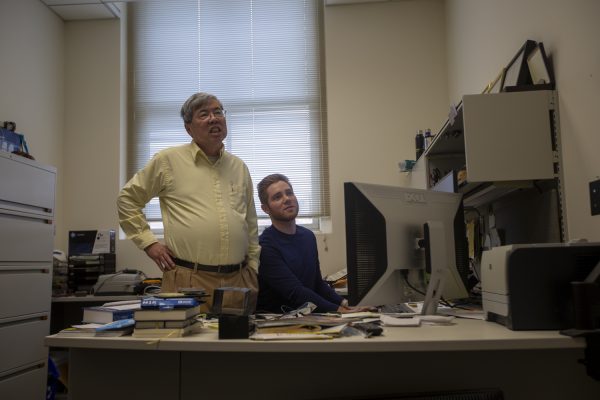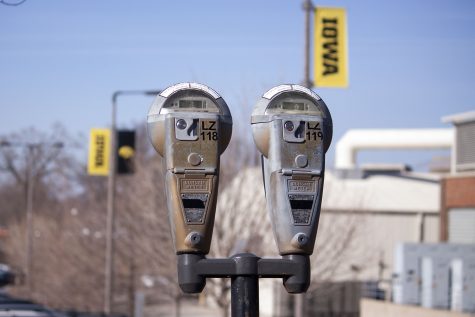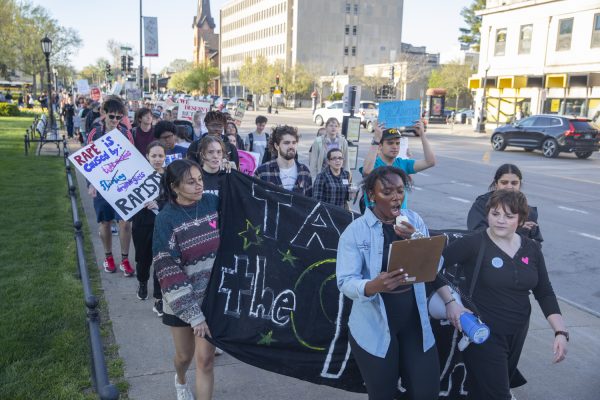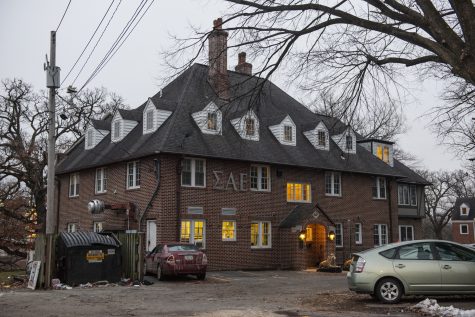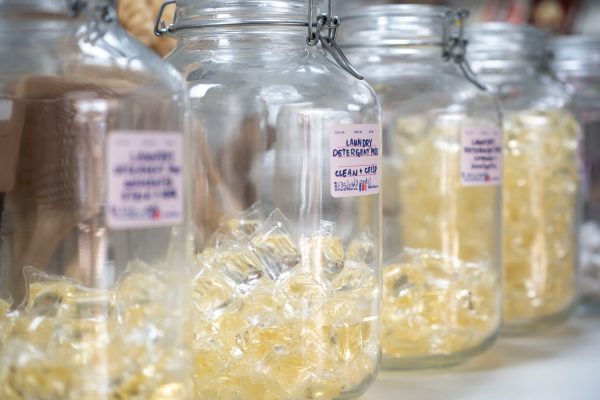Bill Nye encourages climate action at UI’s Hancher Auditorium
Bill Nye visited the University of Iowa’s Hancher Auditorium on Tuesday to discuss climate change and methods of altering its impact.
Bill Nye walks around the stage during a lecture held at Hancher Auditorium in Iowa City on Tuesday, April 26, 2022. Nye spoke about climate change.
April 26, 2022
Bill Nye, who is known for his hit program Bill Nye the Science Guy, spoke on Tuesday about climate change and sustainability at the University of Iowa’s Hancher Auditorium.
Originally scheduled to speak on April 27, 2020, the lecture was postponed twice. Once because of the pandemic, and again in 2021 because of scheduling conflicts.
Throughout his lecture, Nye focused on problems facing the Earth, including climate change and the war in Ukraine.
On the screen onstage, Nye presented a statistic detailing the shift of the amount of CO2 in the Earth’s atmosphere from 0.03 percent in recent history to 0.04 percent today.
“This tiny change, and this tiny fraction, of our atmosphere, is changing the world,” Nye told the audience. “This is not that complicated.”
Among other evidence Nye pulled from to illustrate the climate’s precarious state is a picture of the Russell Glacier in Greenland, which he captured in a photo by plane, he said. He pointed out the obvious: this glacier was hardly composed of ice, especially in the section he showed.
“It’s not that hard to see climate change,” Nye said.
He also described an anecdote from the middle of the Greenland ice sheet involving the observation of ancient bubbles to prove how the atmosphere has changed.
By drilling into the sheet, he said, scientists extract cylinders of ice and observe these bubbles.
“The bubbles are from the ancient atmosphere,” Nye said. “They got there when snowflakes fell and trapped air between their tines, and then fell down and then more snow fell and crushed and crushed and crushed.”
Nye mentioned a hockey stick graph, originally created by Michael Mann, to illustrate the speed at which the climate has warmed in the last few centuries.
“The world is getting warm so fast,” he said. “Everybody, that is the issue.”
The Milankovitch cycles, by which the world grew warmer and had an inland sea in Wyoming, Nye explained, is distinct from the climate change happening now.
“That’s not what’s going on now,” he said. “It’s the speed that the world is getting warmer.”
One reason Nye gave as to why climate change is a current and dangerous reality is the thinness of the atmosphere.
“It’s fantastically thin,” he said. “If you could drive straight up at highway speed, you’d be at outer space in an hour.”
In addition, Nye said the fact of the Earth’s population of 7.9 billion has much to do with climate change.
“The atmosphere is really thin and there’s eight billion of us breathing and burning it,” he said. “That’s how we’re changing the climate. It was something we did on purpose. But what’s happened is now we are in charge. We are running the show.”
Abigail McDaniel, a UI third-year student, attended the lecture and said she thought Nye was authentic.
“I think he was really real with us about giving data and information,” she said. “I think it was really important to see someone we trust, I guess, give us information about climate change.”
Natalie Elizalde, also a UI third-year student, said she is passionate about climate change and was pleased to hear Nye’s thoughts on the topic.
“It’s really nice to hear his thoughts about it as well as how we can improve it overall,” she said. “I did not know about that plan about making that sustainable energy, like how easy it could be to switch it.”
One change Nye proposed to alter the climate dilemma is for people to simply talk about it more.
“The other thing that we could all do, if you want to do something about climate change, is vote,” he said to much applause. “When you vote, take the environment into account. Make that your number one thing.”
Nye said he works with the Solutions Project, which, based on an analysis of U.S. energy usage, believes that the whole country could be run on renewable energy alone. Nye indicated that 25 percent of Iowa’s electricity comes from the wind, a sustainable source.
“Here’s the thing, you guys, there’d be almost three million jobs,” he said. “Renewable energy jobs that would be sustained as long as we wanted to if we just decided to do it. Now peoples, you are in Iowa, you own this man.”





